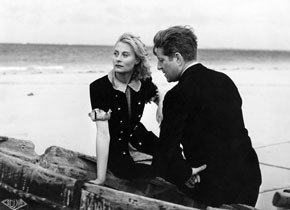Jean Grémillon
May 27 to June 17, 2011
Jean Grémillon belongs to the list of hidden giants of French cinema: He was never considered a “safe bet” as a classic filmmaker. His problematic standing is best illustrated by a quote from a German film encyclopedia: “Grémillon’s persistence in maintaining his independence greatly limited his possibilities. Measured against the high quality of his work, he received relatively little recognition.”
Born in Normandy, Grémillon arrived in Paris at the start of the 1920s – as a musician. Paris was the birthplace of an exuberant avant-garde movement that not only encompassed all of the arts, but also strove to combine them in novel ways. Thus, Jean Grémillon, a musical accompanist to silent films, made the leap to cinema. With his early features, such as Maldone (1928) and Gardiens de phare (1929), he quickly earned a reputation as a master of cinematic Impressionism, although he rejected any dogma of aesthetic virtuosity. Success brought him a commission from the Pathé-Nathan corporation: La Petite Lise (1930) was expected to be a “one hundred percent sound film” and a huge box office success. Grémillon's interpretation of this assignment alienated him from producers as well as from the public: he designed a complex structure of ambient sounds and background music interspersed with long stretches of silence and very little dialogue, so that sound (or its absence) becomes the dominant feature of the film.
Following the downturn in French film production in the early 1930s, Grémillon left the country, but the films he made in Spain and Germany were unfulfilling contract jobs. A genuine star vehicle (still made for the German UFA) enabled him to return to France: Guele d’amour (1937) with Jean Gabin. It was the heyday of poetic realism – and the pessimism of a film like La Petite Lise, which in 1930 had been considered a flaw, suddenly became the hallmark of a flood of new French films. Grémillon was back in demand, although once again he found himself out-of-sync with the mainstream: Remorques (1939-41, written by Jacques Prevert) stands firmly in the poetic-realist tradition, but is also already looking at this tradition from the outside. The characters played by Gabin (tragic hero) and Michèle Morgan (femme fatale) are not so much “lifelike” as they are reflected through great skepticism.
Grémillon's role in poetic-realism is similar to that of Rossellini and neo-realism: if that which was once an alternative to an old and rigid aesthetic has become nothing but style-for-style's sake and has itself become outdated, then it too must be overthrown. Jean Cocteau: "One should avoid wanting to have a style, but in this one must not succeed." Grémillon understood most wonderfully how to make such paradoxes central to his works. It is a sign of his uniqueness and his place as a lone figure between poetic realism and the New Wave that he saw human beings not as being determined by fate, but instead by the interaction between the individual and society, between the internal and the external: people and their surroundings, events and feelings cannot be separated from each other. For him, it was "through realism that one could discover what the human eye can not directly perceive, and thus to reveal harmony and unknown relationships between people." (Peter Nau).
The films he made under the German occupation, Lumière d’été (1943) and Le Ciel est à vous (1944) ultimately placed Grémillon in the top ranks of French directors. "While others sought escape in historical fantasies and police dramas, Grémillon was practically the only one who had the courage to make absolutely contemporary films." (Georges Sadoul) The unyielding timeliness that kept him tethered to his era is manifested in a political-historical perspective (Le 6 juin à l’aube, 1944-46) as well as in his view of gender relations (presented with captivating finesse, as in his last feature film, L’Amour d’une femme, 1953). This is also revealed in his late, no less important documentary works, which arose from Grémillon's affinity for both fine art and traditional crafts: what he describes in these films is not just people, objects and processes, but also his own relationship to these things.
In his last film, André Masson et les quatre éléments (1958), Grémillon approached the work of the painter, graphic artist and sculptor Masson with these words: "Every artist must be both inside and outside of his creation. Inside, to participate in the creation's secret life, and outside so that one can also be a witness." This applies not only to Masson. It can also be read as Grémillon’s own aesthetic and intellectual credo.
The show’s curator, Ralph Eue, has edited a new booklet on Grémillon (SYNEMA Publications, Vienna 2011) and will conduct a research seminar on Grémillon at the University of Vienna.
Related materials
